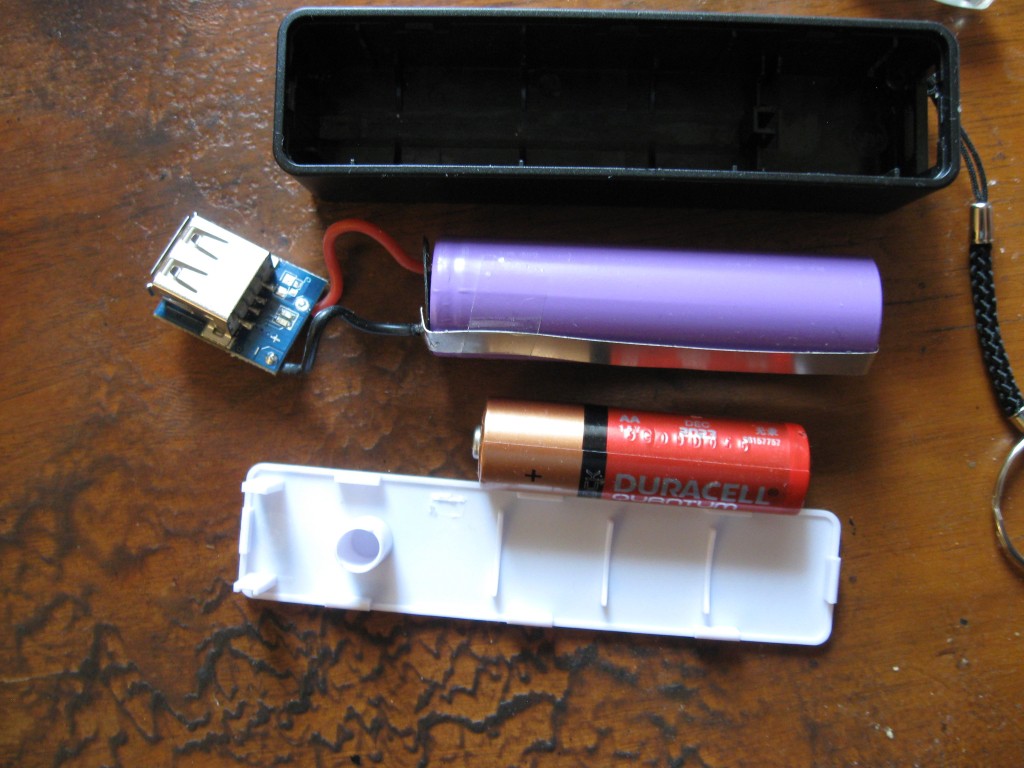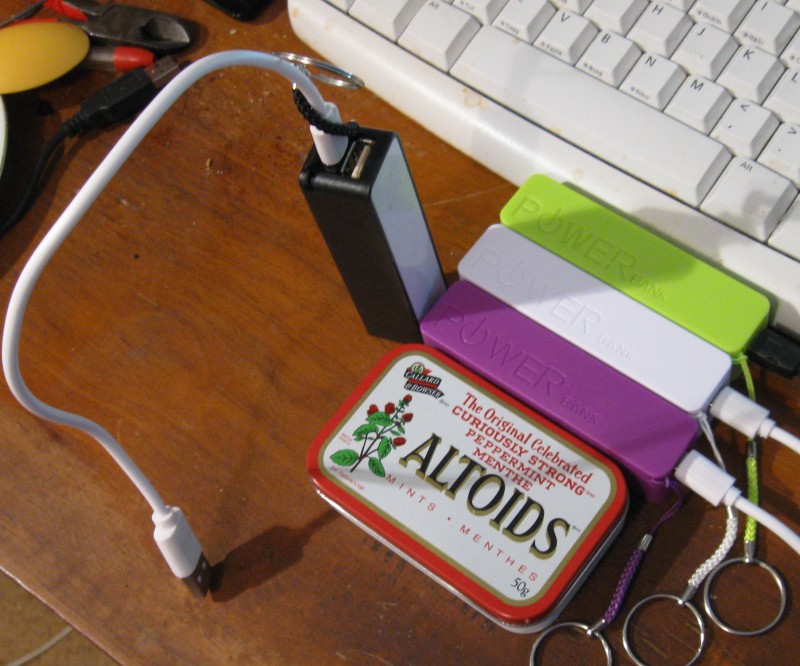Re-purposing Duracell's Powermat Battery Pack
Finding new uses for cheap $3 USB battery packs.
Finding new uses for cheap $3 USB battery packs.
To make the experience fit your profile, pick a username and tell us what interests you.
We found and based on your interests.
I opened up one of the Powerbank packs. It's quite different from the Duracell. The Duracell had a huge number of discrete components, which probably cost a lot. The Powerbank looks like it uses a few stock parts.
Opening it up is easy. The white top is fairly soft plastic, so a small straight screwdriver can gently pry it off. Inside is a tiny board with the connectors, and a larger-than-AA cylindrical LION battery. The wires from the battery are nicely thick. The board has two LEDs: red when charging, blue when powering. One quirk is that it won't do both at the same time, with precedence given to charging, even when it's at full charge.
On the component side, there is one 8 pin chip and two 6 pin chips, a coil and a few other bits. No markings on the chips, but I suspect they are common parts that can be guessed. This is probably the same mass-produced guts inside most similar battery banks. Not bad for $3.

Solar cell results: While the solar cell generated enough voltage to trick the Duracell into thinking it was being charged, switching on the charge LEDs and output, there wasn't enough current to stay ahead of the game. Adding more cells would help, but there will still be boundaries at dusk or cloudy days where the Duracell will be switched on only to lose ground.
Raspberry Pi: That worked well. A RPI 1 B+ with wi-fi running as an open access website can be run for at least two hours. The RPI Zero would be ideal for that. (Tip: Add a clock module if you want to the logs to make sense.) The built-in micro-USB connector makes it neat and tidy.
Where now: The supply of these power packs seems to have dried up. I doubt I'll see any more. I sacrificed three of them for the batteries, and I'm keeping two un-hacked for phone and Pi use.
Meanwhile, more power packs are sliding down the clearance pricing. At the Dollar Store the current $3 special is a "Power Bank" unit of similar capacity, but simpler design without the inductive charging feature. I'll dissect one soon. (Maybe the guts will fit an Altoids tin.)

I finally dug out an old garden solar LED light (still in the bag from an X-Day a few years ago) and extracted the 3" square solar cell. The cheap plastic case had fogged up and was cracking.
In the sun, through a glass window, the cell gives approx 3.5V. Connecting it to the USB charge input does make the battery think that it's charging and the charge level LEDs do light up. Now, the question is: Is the solar cell gaining or losing on the drain from the charge LEDs?
I suppose the next step would be to take a battery with little charge, and leave it in the sun with the solar cell for a day and see what happens. Crude. Too bad I can't talk to the controller in the battery to get the exact charge level.
The solar cell is the same 3" size as the battery, which could be a nice package.
Speaking of packaging, I have a spare Raspberry Pi that I that I'm going to put in a portable case. One of the batteries would fit in nicely, but I'll have to check if it can keep up with a Pi running a wifi access point, maybe a USB camera.
I finally cut up one of the micro USB cables, and tried a couple voltages on the USB charge input.
1.5V - no result.
3.27V - the charge lights lighted. 5V probably appeared on the bank's output, but I have to confirm that.
The next step will be to dig up an old solar patio light. I should be able to get at least 3V from the solar cell, and I'll see what happens with that.
Create an account to leave a comment. Already have an account? Log In.
Yes, I'd noticed that some powerbanks had higher capacities. I expect that they'll trickle down to the Dollar store in the new year. $3 CAN.
The rating on the one that I've opened is 3.7V@7.4Wh = 2000mA, a bit more than what was on the packaging. Like of box of chocolates, I guess.
I might do some mix and match with the powerbank circuit boards and the smaller Duracell batteries for compact power units. The powerbank guts as is will fit an Altoids tin with room to spare for a project. Also, three of those 18650 cells wouldn't be much larger than a 11.1V 1000mA AR Drone battery, but I'll have to weigh them to see if that's a sane idea. ;)
iv added this to the head lamp they have works well and you can charge your phone
Become a member to follow this project and never miss any updates
By using our website and services, you expressly agree to the placement of our performance, functionality, and advertising cookies. Learn More
You can get more of the powerbank style here for $2.90
The battery in these is a 18650 size 2600mA Lithium.
http://www.aliexpress.com/item/2600mAh-mini-External-Portable-Power-Bank-Easy-Battery-USB-Charger-Powerbank-Mobile-Power-For-iPhone-samsung/32325613551.html?spm=2114.01020208.3.102.asnDHC&ws_ab_test=searchweb201556_7,searchweb201644_3_79_78_77_82_80_62,sea...